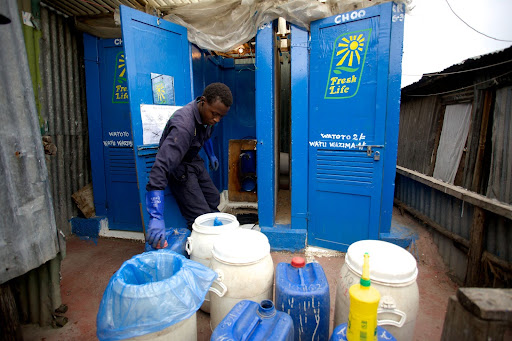
Photo Credit: Nestlé
When considering urban sources of greenhouse gas emissions, sanitation is not usually the first sector that comes to mind. Transportation, sure. Electricity generation, certainly. But not waste treatment. And yet, one study showed that up to half of the greenhouse gas emissions emitted from Kampala, Uganda could be traced to sanitation. This is because methane–a gas that is created from the breakdown of fecal matter–has more than 80 times the warming power of carbon dioxide (CO2) in the short-term. If fecal sludge is not treated properly, methane is released into the atmosphere.
Because of all the health challenges that result from poor sanitation, the U.S. Agency for International Development (USAID) has long supported efforts to expand safely managed sanitation. USAID is broadening this work to focus on the climate benefits that could also result from this approach. According to the Global Methane Initiative, sanitation and waste management are responsible for about 14 percent of global methane emissions. Currently 80 to 90 percent of wastewater and fecal sludge is neither collected nor treated in countries where USAID works.
USAID’s Mission in Kenya was one of the first Missions to make the connection between sanitation and climate change, and has since been working to mitigate methane emissions. The Mission is working with three Kenyan private sector partners to expand safe fecal sludge management.
Regen and Fresh Life, both offshoots of Kenya-based Sanergy, have partnered to turn fecal waste into three different products: insect-based protein for animal feed, biomass fuel briquettes, and organic fertilizer. These products ensure fecal waste is safely treated, keep valuable nutrients in the food chain, and offset around 760 tons of methane, or more than 19,000 tons of CO2 equivalent per year, which is equivalent to the amount of emissions generated from electricity use in over 3,500 American homes for one year. Fresh Life sources the fecal material from a network of community-run container-based toilets placed in neighborhoods in Nairobi that would otherwise lack sanitation facilities. USAID is helping Sanergy scale up its overall waste treatment operation, fertilizer, briquettes, and animal feed production, as well as sanitation coverage.
Sanivation, on the other hand, is working with local governments to develop and maintain sanitation infrastructure by training a corps of workers to empty pit latrines and septic tanks and to construct municipal waste treatment facilities. The company also produces biomass briquettes—so far, more than 5,000 tons—from waste processed in their facilities. These efforts currently abate as much as 80,000 tons of CO2 equivalent worth of methane, or the equivalent to the amount of emissions generated from electricity use in over 15,500 American homes for one year. USAID is supporting Sanivation in structuring business plans, putting together loan applications, and unlocking additional financing.
Before USAID Kenya took methane abatement into consideration with these three partnerships, the Mission designed the Western Kenya Sanitation Project, which also developed biomass products for markets in that part of the country. Though formal targets for methane abatement were not included, the project focused on fecal sludge management. It is estimated that if service providers like Fresh Life and Sanivation served just 10 percent of the one billion people living in urban settlements globally, up to 1.3 million metric tons of CO2 equivalent emissions could be prevented through their reductions in methane emissions– the equivalent of emissions generated from 252,947 American homes’ electricity use for one year. Sanergy is working to quantify and monetize these methane emission reductions through carbon credits on the international market. This would allow Sanergy to receive payments from other companies or organizations looking to offset their own greenhouse gas emissions
Improved sanitation clearly has benefits beyond health, and USAID’s strong partnerships with the private sector help raise awareness and expand those benefits. “Just being able to combine forces with some of the folks who work in this space,” says Amanda Robertson, Senior Water, Sanitation, and Hygiene (WASH) Advisor and WASH Team Lead at USAID/Kenya, “has been really exciting as well. We certainly have our strengths, but partnering with folks that have very complementary ones, I feel like we’ve been able to move the needle a bit further than we would have if we had gone it alone.”

About The Author
Christine Chumbler
Communications professional with more than 20 years experience in writing, editing, and publications design. She has expertise in every stage of publication production, from concept and writing to editing, design, and printing. In the mid-1990s, she was a Peace Corps Volunteer in Malawi. This experience led to a career using her writing and editorial skills with international development and foreign policy organizations, many of which worked to directly support USAID’s efforts. She has worked in a freelance capacity full-time since May 2016. Chumbler has a Master’s in journalism from the University of Michigan and a Bachelor’s in environmental studies from the University of California, Santa Cruz.
*This blog was originally published on ClimateLinks


